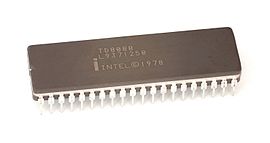
Back إنتل 8088 Arabic Intel 8088 Byelorussian Intel 8088 Bulgarian Intel 8088 Catalan Intel 8088 Czech Intel 8088 German Intel 8088 Greek Intel 8086 y 8088#Pines del 8088 Spanish Intel 8088 Estonian Intel 8088 Finnish
 D8088 in a ceramic DIP with silver pins | |
| General information | |
|---|---|
| Launched | 1979 |
| Discontinued | 1998[1] |
| Common manufacturer |
|
| Performance | |
| Max. CPU clock rate | 5 MHz to 16 MHz |
| Data width | 8 bits |
| Address width | 20 bits |
| Architecture and classification | |
| Application | Desktop, Embedded |
| Technology node | 3 µm |
| Instruction set | x86-16 |
| Physical specifications | |
| Transistors |
|
| Co-processor | Intel 8087 |
| Packages | |
| Socket | |
| Products, models, variants | |
| Variant |
|
| History | |
| Predecessor | Intel 8085 |
| Successors | 80186 and 80286 (both of which were introduced in early 1982) |
| Support status | |
| Unsupported | |
The Intel 8088 ("eighty-eighty-eight", also called iAPX 88)[2][3][4] microprocessor is a variant of the Intel 8086. Introduced on June 1, 1979,[5][6][7][8] the 8088 has an eight-bit external data bus instead of the 16-bit bus of the 8086. The 16-bit registers and the one megabyte address range are unchanged, however. In fact, according to the Intel documentation, the 8086 and 8088 have the same execution unit (EU)—only the bus interface unit (BIU) is different. The 8088 was used in the original IBM PC and in IBM PC compatible clones.
- ^ CPU History – The CPU Museum – Life Cycle of the CPU.
- ^ "iAPX 86, iAPX 88 user's manual" (PDF). Retrieved October 5, 2024.
- ^ "iAPX 86, 88, 186 Microprocessors Part I, Workshop Notebook" (PDF). June 1984.
- ^ "iAPX 286 Programmers' Reference Manual" (PDF). 1983. page 1-1.
- ^ "Microprocessor Quick Reference Guide". Intel. Intel. Retrieved June 1, 2019.
- ^ "Microprocessor Quick Reference Guide". Intel. Intel. Retrieved June 1, 2019.
- ^ Singh, Renu (2006). Microprocessor Interfacing and Applications. New Age International. pp. 2–27. ISBN 81-224-1400-1. Retrieved June 1, 2019.
- ^ Govindarajalu, B. (2002). IBM PC and Clones: Hardware, Troubleshooting and Maintenance (2nd ed.). McGraw-Hill. p. 248. ISBN 978-0-07-048286-9. Retrieved June 1, 2019.